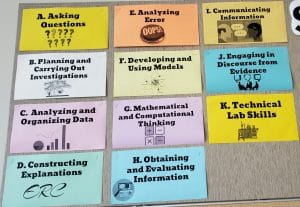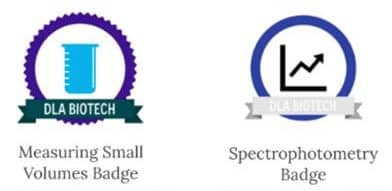Science Competencies and Micro-credentials at Del Lago Academy
CompetencyWorks Blog
This is the second post in a series about Del Lago Academy in Escondido, California. Links to the other posts are at the end of this article.
 Del Lago Academy is a “Campus of Applied Science” whose staff have developed a biotech curriculum with digital badges and strong industry connections. I spoke with 10th-grade science teacher Rita Boyd, who was passionate about building Del Lago’s competency-based approach. Through a multi-year process, the science team developed the following 11 competencies that they call “science and engineering practices”:
Del Lago Academy is a “Campus of Applied Science” whose staff have developed a biotech curriculum with digital badges and strong industry connections. I spoke with 10th-grade science teacher Rita Boyd, who was passionate about building Del Lago’s competency-based approach. Through a multi-year process, the science team developed the following 11 competencies that they call “science and engineering practices”:
 Asking questions
Asking questions- Planning and carrying out investigations
- Analyzing and organizing data
- Constructing explanations
- Analyzing error
- Developing and using models
- Mathematical and computational thinking
- Obtaining and evaluating information
- Communicating information
- Engaging in discourse from evidence
- Technical lab skills
Students in all grades do projects every semester that give them at least two opportunities to work on each competency and demonstrate mastery through a variety of assessments. The teachers ask students to make a case for which science and engineering practices they demonstrated through different elements of their projects. After each assessment, students complete a “Competency Reflections” handout by checking off the practices they used and responding to one of the five “perplexity prompts” below to be used as evidence in their science portfolio.
- Confounds: Explain something that caught you off guard, deeply interested, or surprised you. Something that challenges a prior understanding or something you previously would have found hard to believe.
- Confirms: Explain what confirms what you already know or have experienced. Something that is not surprising at all. Describe what was confirming to you.
- Conducive: Explore a term, phrase, concept, event, or idea that you find particularly conducive to your learning. Describe how your learning or understanding was supported.
- Confuses: Examine something that is unclear and you are working on understanding. This can be a term, idea, a passage (including citation), or concept. Explain what about it is confusing.
- Curious: Express something that you want to learn more about. Indicate what made you curious and what you hope to learn.
The science course grade is currently calculated by averaging a student’s grades on each competency, but in the future the school plans to report a separate grade on each competency. They also aspire to develop learning progressions that locate students’ evidence on a continuum from 9th-grade to 12th-grade levels on each competency. Given the teachers’ devotion and progress on these complex tasks so far, it will be great to hear about their advances in the coming years.
 Science Micro-Credentials
Science Micro-Credentials
Boyd’s 10th-grade science students can also earn three online badges (micro-credentials) for skills in using spectrophotometers, serological pipets, and a genetic engineering technique in which students transform a bacterium using a plasma they make in the lab. To pursue the badge, students first had to receive a ‘4’ grade (extending the competency) on the qualifying class assignments. This led many students who were excited about earning the badge to revise and extend their ‘3’-level work (meeting the competency) from earlier in the year. After qualifying based on their classwork, students needed to upload their evidence, write a reflection, and make a presentation to the class.
Del Lago uses the Portfolium online badging platform, which is part of the Canvas learning management system the school uses. The badges evolved from discussions among several San Diego County schools on topics such as developing a set of required skills and principles for using serological pipets. Then Del Lago aligned those skills and principles with their science competencies, and Portfolium turned that information into a badge. Some other grade levels and academic disciplines at Del Lago are engaging in similar processes to develop badges for selected competencies. More information on this work is available at the CompetencyX website.
Boyd has been using pull-out days to share her badging work with other science teachers. She emphasizes that “It can’t be an add. It has to replace something in your curriculum. And I had the idea this was going to replace my final.” Specifically she was referring to a final exam that most 10th graders had not engaged with seriously for years because it was “do no harm” (couldn’t lower their grade). She tried various strategies to encourage them, but then decided to pursue the badges instead and was very pleased with students’ level of engagement.
The next Del Lago blog post will describe the school’s strategies for personalizing learning and building a positive school culture.
Learn More
- Interdisciplinary Projects and Assessment Practices at Del Lago Academy
- Personalization and Positive School Culture at Del Lago Academy
- A High School With No Students – Only “Scholars”
- Why We Use Digital Badges at Del Lago Academy
- The Challenges of a Large, Diverse School District and the Promises of Performance Assessment Micro-credentials
Eliot Levine is the Aurora Institute’s Research Director and leads CompetencyWorks.